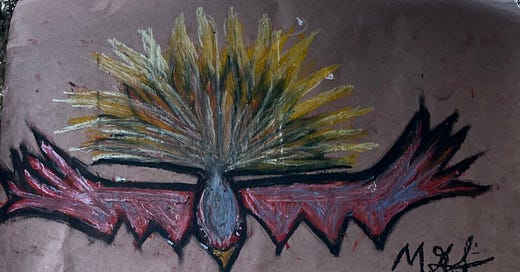The Sound of a Great Bird – Tich Nhất Hạnh
The Sound of a Great Bird
The old path
and his footprints—
the perfume of time does not smell of the violet;
the color of time is not the color of the sky.
Dust on my way,
moss on the wild stone,
soot on the old wood—
time is not flowing.
The unlimited is concentrated—
above my head, the thundering sound of passing wings.
In his very hand is found
the power to open or to close.
Let the wanderer return to his starting point.
I find myself today all alone
at this crossroads
that offers both opening and closing,
mounting and descending.
In a startling moment
the echo of the ages,
the sound of the walking steps,
projected to the present
shakes me
awake.
– Tich Nhất Hạnh, Call Me By My True Names, 1999
The Thunderbird
As long as I can remember, I've been attracted to large birds. Vultures and raptors are fascinating; their skill, their eyesight, their intelligence, and their fierce beauty run through me like a life force. When I was at a firekeepers leadership retreat in September, I sat on a deck in the early morning and watched the sun come up and took in everything that was happening. At that time of day, the senses are super-alert, catching the change of the light on the lake and the trees, smiling at how each visible animal greets the day.
I didn't have to be super awake to notice the strange "thwooping" sounds that intermittently sounded around the deck. It took me a while to match the movement with the sounds. Great turkey vultures were flying over the deck, their wings beating like thunder. You could feel it in your body. "Thwoop! Thwoop!"
I was reminded of the legends of the Thunderbird, who, among other things, brought on the rain and thunder by flapping its great wings. I could imagine that association with the smaller turkey vulture. The magnificent California Condor has a wingspan of up to 10.5 feet, as compared to the turkey vulture's six-foot wingspan. The condor weighs in at 20-24 lbs, as opposed to the turkey vulture's 3.3 lbs. This HUGE bird became extinct in the wild, and in 1982 there were only 22 condors living in captivity. Through conservation efforts, there are more than 300 animals in the wild, with another 200 in captivity.
The thunderbird is a powerful symbol, and it's not hard to see why. Tich Nhất Hạnh's "Great Bird sounds and "The unlimited is concentrated— /above my head, the thundering sound of passing wings." I don't know if you have to have felt the sound of thundering wings to imagine the Thunderbird, but understanding of the animal—biological and mythical—is cemented in the soul with the beating of those wings.
After my experience at the retreat, I meditated on giving myself into the feeling of groundlessness, and had a vision in which, feeling no ground beneath me, I realized I was flying. I was the Thunderbird, riding the thermals, rising with the warmth. As I saw the forest spread out before me, I wondered what was behind me. The blue sky and all the heavens were behind me, being above me. My startled soul was shook awake.
Afterwards, I painted a series of Thunderbirds. This one is the largest, around three feet wide, painted with oil stick on rosin paper. I told my friend Susan about my vision, and she presented me with a turkey vulture feather that presented itself to her decades ago. I keep it in a box with my bone collection and artemisia (white sage).





